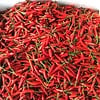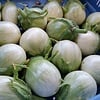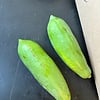Pandang leaf Big ( 10 x 100gram) - 1kg.
Description/Taste
Pandan leaves are medium to large in size and are elongated, narrow, and oblong in shape. There are two distinct Pandan plant shapes. If the plant is left undisturbed and the leaves are not harvested, it will develop into a small tree with large, long, and thin green leaves that can reach up to two meters in length. If the leaves are continuously harvested, the plant will stay low to the ground forming a shrub-like appearance with smaller, narrow green leaves growing up to one meter in length. The upright green leaves taper to a point at the tip, and when attached to their stems, Pandan leaves resemble the top of a pineapple plant. Pandan leaves have a unique and distinct grassy aroma when first crushed that mellows out to a subtle, herbal, and floral aroma. When cooked, Pandan leaves have a nutty, almond, rose-like, and slightly sweet flavor.
Seasons/Availability
Pandan leaves are available year-round.
Current Facts
Pandan leaves, botanically classified as Pandanus amaryllifolius, grow on an herbaceous tropical plant that is rare to find in the wild but is widely cultivated. Also known as Screwpine in English, Rampe in Hindi, Takonoki in Japanese, Daun Pandan in Malaysian, Bai Toey Hom in Thai, and Chan Xiang Lan in Mandarin, Pandan leaves are the only Pandanus species with fragrant leaves and are commonly used to flavor meat, rice, curries, and various desserts.
Nutritional Value
Pandan leaves are rich in essential oils, glycosides, and alkaloids, and also contain traces of tannin and isoprene esters. They are traditionally used to reduce symptoms of pain and fevers and are used as a laxative.
Applications
Pandan leaves are best suited for cooked applications such as boiling, steaming, sautéing, and frying. They are used in both sweet and savory dishes and are boiled, pounded, bruised, or raked to bring out the flavor. Pandan leaves are often used to wrap meats or sticky rice and are cooked to add a sweet and nutty flavor. They are also wrapped and deep fried to create a crunchy exterior. In addition to savory preparations, Pandan leaves are also used to make desserts and drinks. They can be made into a paste with the juice extracted to make the well-known chiffon cake, and they can be cooked to make Kaya, or pandan-flavored coconut egg jam, which is a traditional Pandan dish still found today in Malaysia and Singapore. Pandan leaves can also be cooked with coconut to make nasi lemak rice or are tied into knots and used for flavoring. Pandan leaves pair well with turmeric, lemongrass, brown sugar, milk, meats such as fish, chicken, beef, and pork, and rice. They will keep for a couple of days when stored unwashed, wrapped in a damp paper towel and sealed in a plastic bag in the refrigerator. Pandan leaves can also be frozen for up to two months.
Ethnic/Cultural Info
Pandan leaves are widely used in Indonesia and Malaysia as an insect repellent to keep away pests like cockroaches and ants. They are also used as air fresheners in homes and are cut thinly and mixed with other scents to make a potpourri that is traditionally given during weddings. Pandan leaves are also used in religious celebrations in India as they are said to be holy to the gods Shiva and Ganesh. In some Indian villages, the leaves are tossed into open wells to create a sweet smell and flavor in the drinking water.
Geography/History
The origins of Pandan leaves is relatively unknown, but it is believed to be native to Southeast Asia and is still widely cultivated there. Today Pandan leaves can be found fresh and frozen at specialty grocers in South India, Southeast Asia, Indonesia, Sri Lanka, and West New Guinea.



 vegetables
vegetables
 fruit
fruit
 chilli
chilli
 eggplant thai
eggplant thai
 NEW project - GREEN PAPAYA THAI.
NEW project - GREEN PAPAYA THAI.



